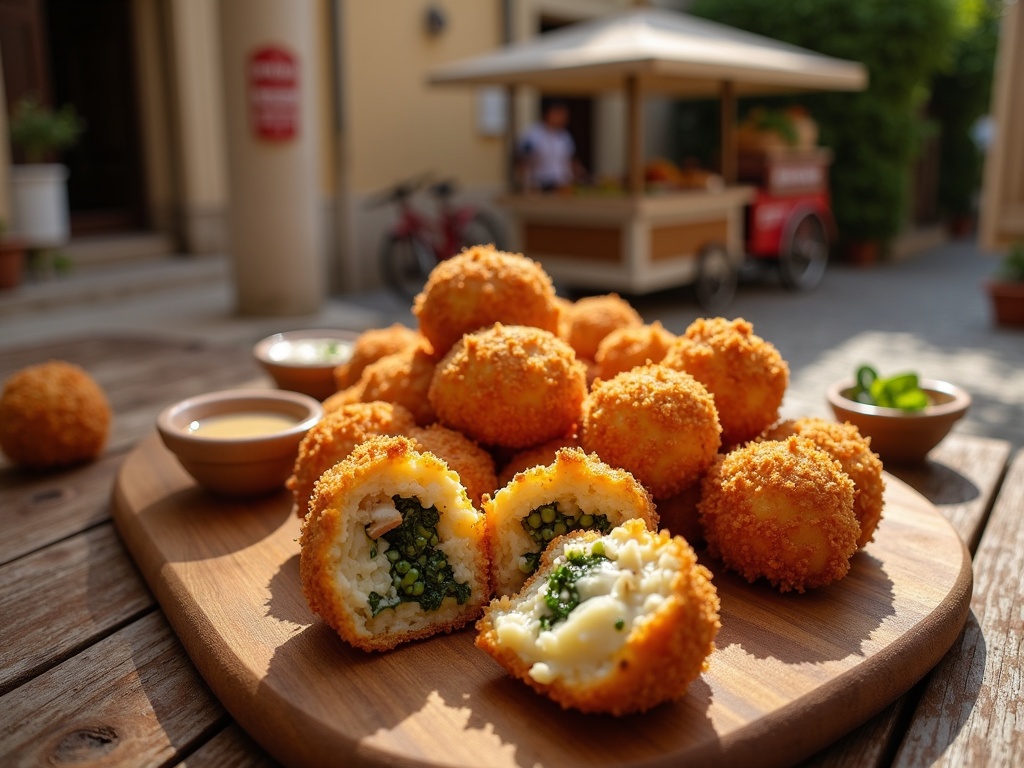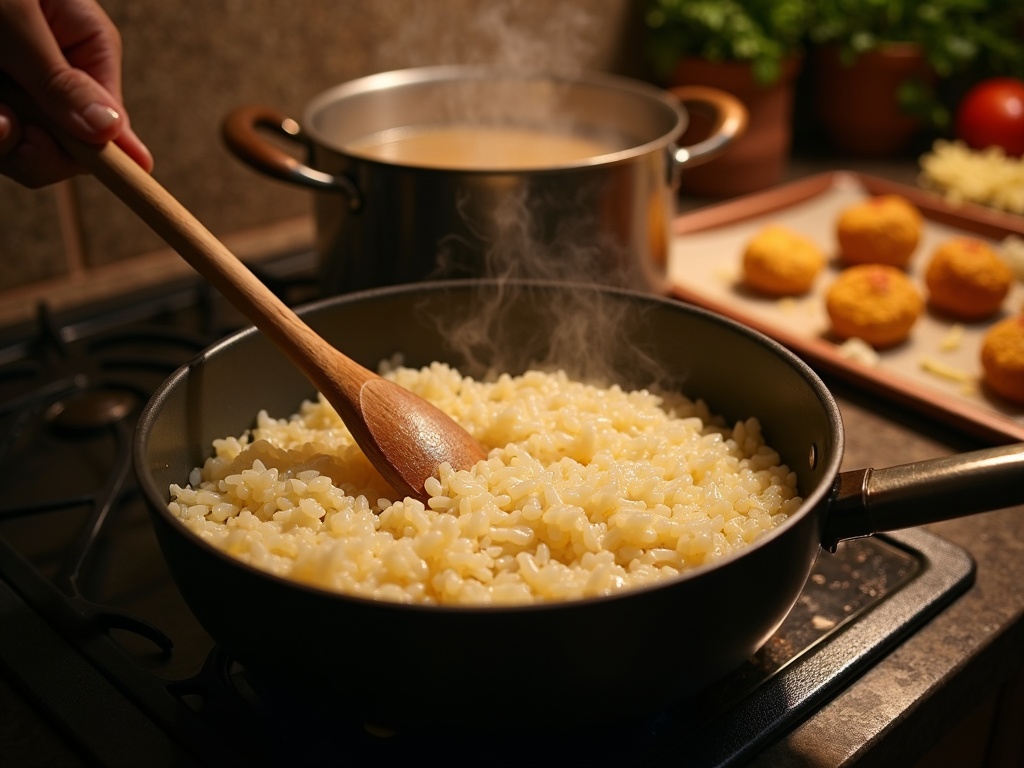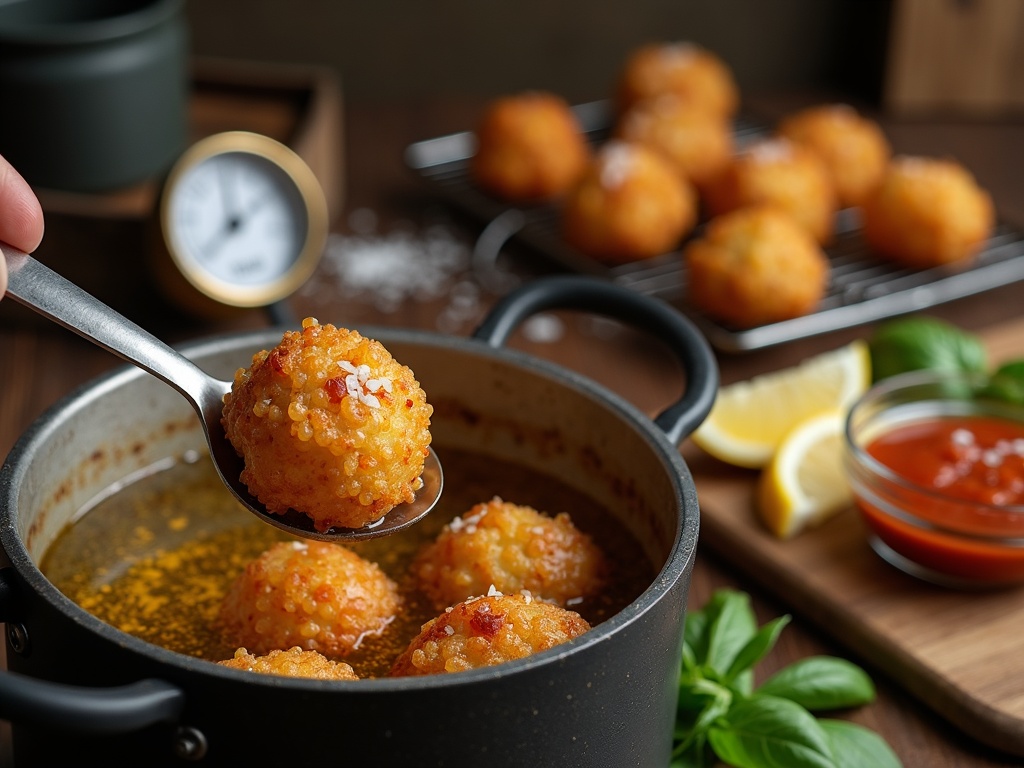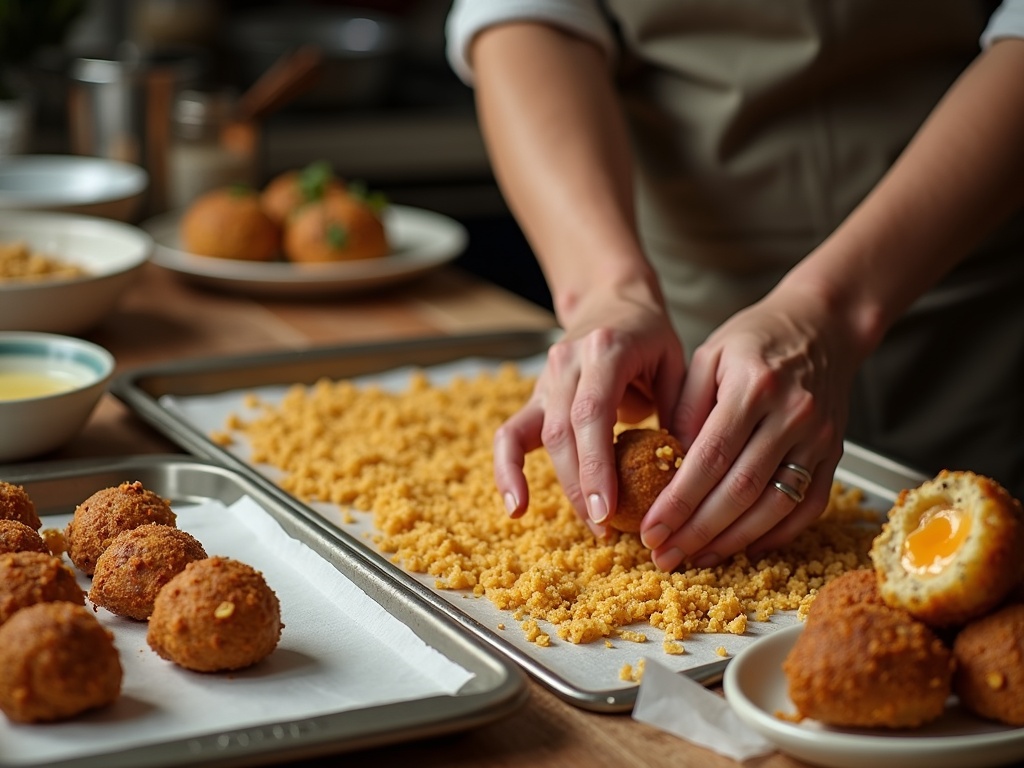Arancini: The Golden-Fried Sicilian Delight
Arancini recipe, the golden-fried Sicilian rice balls, transform basic ingredients into a delightful treat with their crispy exterior and creamy risotto interior. These versatile Italian street food favorites started as a smart way to use leftover risotto, showing how Italian cooking turns simple components into extraordinary dishes.
Table of Contents
Key Takeaways
- Start with properly cooked, completely cooled risotto as the base for forming stable arancini balls
- Use Arborio rice for its high starch content, which creates the perfect creamy yet firm texture
- Traditional fillings include ragù with peas, mozzarella, prosciutto, or vegetarian options like mushrooms or spinach and ricotta
- Maintain oil temperature at 350°F when frying to achieve the signature golden-brown exterior without greasy results
- Arancini can be prepared ahead of time and are perfect for entertaining, with the option to customize fillings based on preference
Perfecting the Base
Good arancini depend on starting with properly cooled risotto. The rice needs time to set so the balls hold their shape during frying. Arborio rice works best thanks to its high starch content, which delivers the distinctive creamy-yet-firm texture that defines perfect arancini.
Creative and Classic Fillings
The filling options are endless. I often use classics like ragù with peas or simple mozzarella centers, but I also enjoy creating vegetarian-friendly versions with mushroom or spinach and ricotta. The most important filling rule? Moist but not watery for the best consistency and flavor.
Mastering the Fry
Temperature control matters tremendously during frying. I maintain my oil at exactly 350°F — hot enough to create a crisp golden crust without burning, but not so hot that the exterior cooks before the center is heated through.
Serving and Entertaining
For parties, arancini can be prepared ahead of time and kept warm in the oven. Guests love their customizable nature, and they pair beautifully with a variety of dipping sauces such as a simple tomato sauce or a garlic-infused aioli.
- Prepare risotto and cool it thoroughly.
- Create your favorite filling combinations.
- Form into balls, coat with breadcrumbs, and fry at 350°F.
- Keep warm in the oven until serving.
What Are Italian Rice Balls?
Arancini, also known as Italian rice balls, are a delightful Sicilian street food that has captured the hearts of food enthusiasts worldwide. These golden-fried treasures feature a crispy exterior that gives way to a creamy risotto interior, making them an irresistible treat for any occasion. While they might seem fancy, they’re actually based on humble ingredients transformed into something extraordinary.
The name “arancini” comes from the Italian word “arancia,” meaning orange, which these rice balls resemble in both color and sometimes size. Traditional arancini originated in Sicily as a way to repurpose leftover risotto, demonstrating the Italian knack for transforming simple ingredients into exceptional dishes, much like the famous Bolognese sauce that makes use of basic ingredients.
The Anatomy of Perfect Arancini
At their core, arancini consist of risotto rice that’s been cooked to creamy perfection, then shaped around various fillings before being breaded and fried to golden perfection. The outer coating typically features breadcrumbs that crisp up beautifully during frying, creating that signature crunch when you bite into them.
The interior is where arancini truly shine. The risotto rice remains tender and creamy, complemented by fillings that can include:
- Ragù (meat sauce) with peas, similar to those used in other Italian dishes
- Mozzarella or other melting cheeses that create that coveted cheese pull
- Prosciutto or ham for a salty complexity
- Mushrooms for an earthy vegetarian option
- Spinach and ricotta for a creamy, herbaceous center
- Butternut squash for a slightly sweet variation
What makes arancini truly special is their versatility. I’ve seen them served as elegant appetizers at upscale restaurants, offered as street food from vendors in Sicily, or presented as the star of a main course alongside a simple salad. They’re substantial enough to satisfy hunger yet refined enough for special occasions.
The contrast between the crispy exterior and the soft, flavorful filling makes each bite an experience in textural delight. When made properly, the arancini should maintain their structure while still yielding to reveal their savory centers.
Traditional arancini are typically shaped into rounds or cones, with the cone shape often indicating a meat-filled variety in Sicily. The size can vary significantly—from small, one-bite versions perfect for appetizers to larger, baseball-sized portions that serve as a complete meal.
While they share some similarities with other fried rice balls found in world cuisines, the Italian approach to arancini—with its risotto base and Mediterranean fillings—creates something uniquely satisfying. They’re related to but distinct from Spanish croquetas or paella-based dishes.
Making arancini at home might seem challenging at first, but the process becomes straightforward once broken down into steps. The key is starting with properly cooked, cooled risotto that has enough starch to hold together when shaped. When prepared with care, these crispy rice balls transform simple ingredients into an impressive dish that will have everyone asking for seconds.
Whether you’re serving them as party appetizers, a main course, or a grab-and-go snack, arancini represent Italian cuisine at its best—transforming everyday ingredients into something extraordinary through technique and tradition.

Why You’ll Love Making These
Arancini, those delightful Sicilian rice balls, have become my go-to recipe whenever I need something that’s guaranteed to impress. I’ve found these golden, crispy treats to be incredibly versatile and surprisingly simple to prepare once you get the hang of the technique.
Perfect for Planning Ahead
One of the biggest advantages of making arancini is their make-ahead friendly nature. I can prepare the rice mixture a day or two in advance, shape the balls, and even bread them ahead of time. Then I just store them in the refrigerator until I’m ready to fry. This has saved me countless times when hosting dinner parties or contributing to potlucks.
The preparation can be broken down into stages:
- Cook the risotto and cool it completely
- Form the balls with fillings
- Bread the arancini
- Refrigerate until ready to fry
This flexible timeline means I can work around my schedule rather than rushing everything on the day of serving. For especially busy weeks, I’ve even frozen the breaded (but unfried) arancini for up to a month with excellent results.
A Guaranteed Crowd-Pleaser
Few appetizers generate the excitement that a platter of freshly fried arancini does. There’s something magical about breaking through that crispy exterior to reveal the creamy risotto and melty cheese inside. I’ve served these at everything from casual game nights to upscale dinner parties, and they’re consistently the first thing to disappear.
The appeal crosses generations too. Kids love the crispy-on-the-outside, gooey-on-the-inside texture, while adults appreciate the sophisticated flavors that complement a glass of wine perfectly. They’re substantial enough to satisfy hunger without filling guests up before the main meal, making them ideal for Italian-themed gatherings or pre-dinner socializing.
Endlessly Customizable Options
While traditional Sicilian arancini often feature ragù, peas, and mozzarella, I’ve discovered these rice balls are a fantastic canvas for creativity. The filling possibilities are virtually endless:
- Classic combination of meat ragù, peas, and mozzarella
- Mushroom and truffle oil for an earthy, vegetarian option
- Spinach and ricotta for something lighter
- Caramelized onion and Gruyère for French-inspired flavors
- Spicy ‘nduja sausage and scamorza for heat-lovers
Beyond the fillings, the risotto base itself can be customized with different herbs, spices, or even saffron for that authentic golden hue. I particularly enjoy adding a touch of homemade pesto to the rice mixture for an extra layer of flavor.
The coating offers room for experimentation too. Traditional breadcrumbs work beautifully, but panko creates an extra-crispy shell, while seasoned breadcrumbs can add another dimension of flavor.
Brilliant Solution for Leftover Risotto
I’ve always found that risotto, as delicious as it is freshly made, rarely shines as a leftover. It tends to firm up in the refrigerator, losing that perfect creamy consistency that made it special the first time around. That’s where arancini come in as a genius solution.
The cooled, firmer texture of day-old risotto is actually perfect for shaping into balls. Rather than attempting to revive leftover risotto (which never quite works), transforming it into something new and arguably even more delicious is deeply satisfying. I’ve even begun intentionally making extra bolognese sauce and risotto specifically to create arancini the following day.
This clever repurposing reduces food waste while creating something that’s often more anticipated than the original risotto itself – a rare culinary win-win that makes me feel both resourceful and creative in the kitchen.

Ingredients You Will Need
Creating perfect arancini requires specific ingredients that build authentic flavor and the right texture. I’ve found that starting with high-quality components makes a significant difference in the final result.
Essential Components for Authentic Arancini
Arborio rice forms the foundation of any good arancini recipe. This short-grain rice has a high starch content that creates the creamy, yet firm texture essential for proper Sicilian rice balls. I cook it with chicken or vegetable broth rather than water to infuse more flavor from the beginning. A splash of white wine added during cooking introduces complexity and acidity that balances the richness.
The cheese components play dual roles in arancini. Freshly grated Parmesan cheese gets mixed directly into the rice for flavor, while cubed mozzarella creates that irresistible melty center when you bite into the finished ball. For the meat filling, either ground beef or Italian sausage works wonderfully, with sausage adding extra seasoning and character to the traditional Italian dish.
The coating requires a few key ingredients:
- Breadcrumbs (preferably panko for extra crispiness)
- Beaten eggs to help the breadcrumbs adhere
- A pinch of salt to enhance all flavors
Don’t overlook fresh herbs which elevate the entire dish. Chopped parsley, basil, or oregano mixed into either the rice or meat filling adds brightness against the richness. Some cooks also add a pinch of saffron for authentic color and flavor.
For frying, vegetable oil with a high smoke point works best. I’ve found that canola or peanut oil maintains consistent temperature during the cooking process, resulting in that perfect golden exterior without burning. While traditional Italian appetizers like bruschetta require minimal cooking, arancini demand proper frying technique.
Remember that proper seasoning throughout each component—the rice, the filling, and even the breadcrumb mixture—creates layers of flavor that make truly memorable arancini. I always taste and adjust salt levels before forming the balls to ensure perfect balance.
How to Make Perfect Risotto Base
Crafting the ideal risotto base is crucial for authentic arancini. This foundation determines the texture and flavor of your finished rice balls, making it essential to get right. I’ve found that patience and attention to detail make all the difference when preparing this classic Italian rice dish.
Preparing the Risotto Foundation
The first step in creating a stellar risotto base begins with properly toasting the rice. I start by heating a tablespoon of olive oil in a heavy-bottomed pan over medium heat. When the oil starts to shimmer, I add my Arborio rice—a short-grain variety perfect for traditional Italian dishes like arancini.
Toasting the rice isn’t just for show—it creates a protective coating around each grain that prevents it from becoming too mushy during cooking. I gently stir the rice for about 2-3 minutes until it becomes translucent around the edges but remains white in the center. This step infuses the rice with a subtle nutty flavor that elevates your final arancini.
The liquid addition technique makes or breaks your risotto. I keep my broth warm in a separate pot—using cold liquid would interrupt the cooking process and result in uneven texture. Adding the broth gradually, about half a cup at a time, allows the rice to absorb each addition before introducing more. This patience pays off in the creamy consistency that’s characteristic of perfect risotto.
Mastering the Stirring Technique
Continuous stirring is often the most misunderstood aspect of risotto-making. I stir consistently—not frantically—to release the rice’s natural starches without breaking the grains. This creates that signature creaminess without turning your risotto into mush.
The process typically takes 18-20 minutes from the first addition of broth. You’ll know your risotto is done when the grains are tender but still have a slight firmness in the center—what Italians call “al dente”. For arancini specifically, I aim for a slightly firmer texture than regular risotto since the rice will continue to soften slightly as it cools.
After your risotto reaches the perfect consistency, remove it from heat and spread it on a baking sheet to cool completely. This cooling step is non-negotiable for rice-based recipes like arancini—attempting to form balls with warm risotto will result in a sticky mess that won’t hold shape.
Consider These Key Factors for Risotto Base Success
- Use the right rice (Arborio, Carnaroli, or Vialone Nano)
- Keep your broth hot throughout the cooking process
- Add liquid gradually, waiting until each addition is absorbed
- Stir continuously but gently
- Cool completely before shaping into arancini balls
The perfect risotto base should maintain distinct grains suspended in a creamy matrix—not too loose or porridge-like. Once cooled, it should be firm enough to shape yet retain enough starch to bind together when formed into balls.
This foundational technique creates the ideal canvas for arancini fillings like cheese, meat ragu, or peas. The subtle flavor of a properly made risotto complements these fillings without overwhelming them, while its texture provides the structural integrity needed for the perfect crispy-outside, creamy-inside contrast that makes arancini so irresistible.
Remember that your risotto should be slightly more al dente than you’d serve as a standalone dish, as it will absorb some moisture from the filling ingredients and soften slightly during the frying process.

Assembling Your Arancini
Creating perfectly formed arancini requires a bit of technique, but it’s a satisfying process that yields impressive results. The assembly stage is where your risotto transforms into those iconic stuffed rice balls that Sicily is famous for. I’ll guide you through each critical step to ensure your arancini turn out just right.
Shaping and Filling the Rice Balls
Once your risotto has completely cooled (ideally refrigerated for at least 2 hours), it’s time to begin the shaping process. Cold risotto is much easier to handle and maintains its shape better when forming the balls.
First, I dampen my hands slightly with water to prevent the rice from sticking. Then I scoop about 3–4 tablespoons of the cold risotto into my palm and flatten it slightly, creating a disc shape. The exact size depends on your preference – traditional Sicilian arancini can range from golf ball to tennis ball size.
Next comes the exciting part – creating a cavity for your filling. Using my thumb, I press gently into the center of the rice disc to form a bowl-like depression. This hollow needs to be deep enough to hold a generous amount of filling but still leave enough rice around the edges to seal completely.
For the filling, a combination of meat and cheese creates the most authentic flavor profile. I spoon about 1–2 teaspoons of your prepared meat mixture (which pairs beautifully with a homemade Bolognese sauce if you’re making traditional arancini) into the cavity, then add a small cube of mozzarella or a pinch of grated cheese.
The final shaping step requires careful attention. I fold the edges of the rice over the filling and gently roll the ball between my palms, applying just enough pressure to seal everything inside without squishing the rice. The goal is a completely enclosed ball with the filling safely tucked in the center.
The Coating Process
The coating is what gives arancini their characteristic golden crunch. This three-step process creates that perfect exterior that contrasts so wonderfully with the creamy interior.
For efficient coating, I set up a breading station with three separate bowls:
- Bowl 1: Plain all-purpose flour
- Bowl 2: Beaten eggs (2–3 eggs with a splash of water)
- Bowl 3: Seasoned breadcrumbs (Italian-style breadcrumbs work perfectly with traditional Italian dishes like this)
I’ve found this sequence works best for creating that perfect crust:
- Roll each formed rice ball in flour, shaking off any excess. The flour helps the egg adhere properly.
- Dip the floured ball into the beaten egg, ensuring it’s completely coated.
- Finally, roll it in the breadcrumbs, pressing gently to help them stick.
For an extra-crispy coating, I sometimes double-dip by repeating the egg and breadcrumb steps. This creates an especially substantial crust that stands up well to frying.
The breadcrumbs can be enhanced with additional flavors – a bit of grated Parmesan cheese, dried herbs, or lemon zest can add wonderful complexity to the final taste. Many Sicilian cooks add a pinch of saffron to their breadcrumbs for both flavor and that lovely golden color.
Once coated, I place each arancini on a parchment-lined baking sheet and refrigerate them for at least 30 minutes before frying. This chilling time helps them maintain their shape during cooking and prevents them from falling apart in the hot oil.
The finished arancini should be uniform in size with a well-sealed exterior – any gaps might cause the filling to leak during frying. When done correctly, each one becomes a perfect package of creamy rice, savory filling, and crisp exterior that’s ready for the final cooking stage.
Frying Instructions
The final step in creating perfect arancini requires careful attention to the frying process. Getting this stage right transforms your rice balls into the crispy, golden delights that make authentic Italian dishes so irresistible.
Oil Temperature and Frying Technique
I always heat my oil to exactly 350°F before frying arancini. This temperature is crucial – too cool and your arancini will absorb excess oil becoming greasy, too hot and they’ll burn on the outside while remaining cold in the center. A deep-fry or candy thermometer is invaluable here for accuracy.
Pour enough vegetable or canola oil into a heavy-bottomed pot to reach about 3 inches in depth. This gives your arancini enough room to float without touching the bottom. Once the oil reaches temperature, I carefully lower 2–3 arancini into the oil at a time, giving them plenty of space. Overcrowding the pot will cause the oil temperature to drop significantly, resulting in soggy rice balls.
The arancini need about 3–4 minutes in the hot oil. I gently turn them occasionally using a slotted spoon to ensure even browning. You’re looking for that perfect golden-brown exterior that signals a crispy crust. The contrast between this outer shell and the creamy rice interior creates that signature texture that makes arancini special.
Draining and Serving
Once the arancini reach that beautiful golden color, I immediately remove them from the oil using a slotted spoon or spider strainer. Properly draining the excess oil is essential for the final texture. I place the fried arancini on paper towels or a wire rack set over a baking sheet. The paper towels absorb excess oil while the arancini cool slightly.
Be sure to let them drain for just 1–2 minutes – this brief resting period allows the exterior to set up perfectly while maintaining the hot, molten center. I like to sprinkle them with a touch of flaky sea salt while they’re still hot.
Timing is everything with arancini. These crispy treats must be served immediately for the best experience. The magic moment is when you break through that crunchy exterior to reveal the steaming, creamy rice and melted cheese center. I often serve mine with a side of warm homemade Bolognese sauce or a simple marinara for dipping.
For an extra special presentation, I arrange the arancini on a platter with fresh basil leaves and offer lemon wedges on the side. The brightness of fresh lemon juice cuts through the richness of the fried rice balls perfectly.

Common Mistakes to Avoid
Making arancini at home can be straightforward, but there are several pitfalls that often trip up first-time cooks. I’ve identified the most common errors and how to avoid them, ensuring your Italian rice balls turn out perfectly crispy on the outside and deliciously gooey on the inside.
Temperature Troubles
Using warm risotto is perhaps the biggest mistake new arancini makers encounter. Freshly made risotto is too soft and sticky to form into proper balls. Instead:
- Always chill your risotto thoroughly in the refrigerator for at least 4 hours or overnight
- Cold risotto holds its shape better and is much easier to handle
- The cooler temperature helps the cheese filling stay in place during frying
- If pressed for time, spread risotto on a sheet pan for faster cooling
Another temperature-related mistake involves the frying oil. Many home cooks get this wrong, resulting in either soggy or burnt arancini. The oil should be heated to 350°F (175°C) for optimal results. Too cool, and your arancini absorbs excess oil becoming greasy; too hot, and the exterior burns before the inside warms through.
Structural Problems
Not properly sealing your arancini can lead to disappointing results. When the filling leaks out during frying, you’ll end up with messy, hollow balls and a dangerous oil splatter situation. I’ve found these techniques helpful:
- Wet your hands slightly before forming each ball to prevent sticking
- Create a well in your risotto portion, add filling, then gently close and shape
- Double-check for cracks or thin spots before breading
- Apply gentle, even pressure when forming the balls
Overstuffing is another common error that leads to structural failure. While the traditional Italian dish is known for its delicious filling, using too much will compromise the integrity of your arancini. Stick to about 1 tablespoon of filling for a standard-sized rice ball. This ensures a perfect ratio of creamy risotto to melty cheese or savory meat filling.
For beginners, I recommend starting with simple cheese fillings before advancing to more complex options like rich bolognese sauce or seafood mixtures. The more solid fillings are easier to contain while you master the technique.
By avoiding these common mistakes, your homemade arancini will rival those found in the best Italian restaurants. The key is patience with the process and attention to these critical details.

Storage and Reheating
After making a delicious batch of arancini, proper storage ensures these Italian rice balls stay fresh and maintain their crispy exterior. I’ve found that keeping leftover arancini in an airtight container is essential to preserve their texture and flavor. This simple step prevents them from absorbing refrigerator odors while maintaining moisture levels in the rice filling.
Best Storage Practices
For maximum freshness, I recommend refrigerating your arancini immediately after they’ve cooled to room temperature. When stored properly in an airtight container, these savory treats remain good for up to 3 days in the refrigerator. If you’ve made a large batch, consider layering them with parchment paper to prevent sticking.
Before storing, make sure your arancini have completely cooled down. Placing warm arancini in containers can create condensation that softens the crispy exterior. For the best results, I let them cool on a wire rack for about 30 minutes before transferring them to storage containers.
Reheating for Optimal Results
The reheating method you choose makes a significant difference in how your Italian rice balls taste the second time around. For the best results, I reheat arancini in a conventional oven at 350°F for about 10–15 minutes. This method restores the crispy exterior while ensuring the filling heats through evenly.
I strongly advise against using a microwave for reheating. While it’s quicker, microwaving tends to make arancini soggy, destroying the delightful textural contrast between the crunchy coating and creamy rice interior. If you’re short on time, a toaster oven works as a decent alternative to a conventional oven.
These storage tips pair perfectly with traditional homemade pesto as a delicious dipping sauce when serving your reheated arancini. The fresh herb flavors complement the rich, savory rice balls beautifully.
For an extra crispy exterior when reheating, lightly spray or brush the arancini with olive oil before placing them in the oven. This simple trick helps restore that just-fried texture that makes arancini so irresistible, even when they’re leftovers.

Pro Tips for Success
Making arancini at home might seem challenging, but with a few expert techniques, you’ll create restaurant-quality rice balls every time. I’ve learned these tricks through years of testing and perfecting my technique.
Perfect Preparation
Use cold risotto straight from the refrigerator for best results. Chilled risotto firms up and becomes more manageable, making it easier to shape into balls without falling apart. I like to prepare my risotto a day ahead specifically for this reason.
Keep your hands wet while shaping the arancini. This simple trick prevents the rice from sticking to your fingers, allowing for smooth, perfectly formed balls. I keep a small bowl of water nearby and dip my hands frequently during the shaping process.
The coating process deserves special attention for truly exceptional arancini:
- Double coat in breadcrumbs for extra crispiness
- Apply firm but gentle pressure when coating to ensure breadcrumbs adhere properly
- Use panko breadcrumbs for extra crunch that perfectly complements the creamy Italian rice filling
Frying Fundamentals
Maintain consistent oil temperature throughout the cooking process. Temperature fluctuations can lead to unevenly cooked arancini—too cool, and they’ll absorb excess oil; too hot, and they’ll burn before cooking through. I recommend using a deep-fry thermometer and aiming for 350°F (175°C).
Don’t overcrowd the frying pot. Adding too many arancini at once dramatically lowers the oil temperature, leading to greasy, soggy balls. Instead, fry in small batches, allowing each ball enough space to cook evenly.
For a healthier alternative, you can adapt these traditional Italian appetizers for the air fryer. While not identical to deep-fried versions, they’ll still develop a satisfying crispness with significantly less oil.
After frying, drain your arancini on paper towels, but serve them promptly. These golden spheres are at their absolute best when fresh from the fryer—crispy outside, with that magical moment when you break through to the creamy, molten interior.
Serving Suggestions
Creating the perfect arancini is just the beginning of a memorable dining experience. The way you present and serve these crispy Sicilian rice balls can elevate them from a simple appetizer to an impressive centerpiece. I’ve found that thoughtful accompaniments complement the rich flavors and textures of arancini, making each bite even more enjoyable.
Perfect Pairings for Your Arancini
A warm, tangy marinara sauce is the classic dipping companion for arancini. The acidity and brightness of tomatoes cut through the richness of the fried rice balls, creating a balanced flavor profile. For the best experience, serve your marinara in small individual ramekins beside each portion of arancini. This not only looks appealing but also prevents double-dipping when sharing with others. If you’re looking for other Italian-inspired dishes to complement your arancini, check out some traditional Italian recipes and techniques for a complete meal.
Fresh herbs aren’t just a garnish – they’re an essential flavor component. Sprinkle finely chopped basil, parsley, or oregano over your arancini just before serving. The herbs provide a pop of color against the golden-brown exterior while adding aromatic freshness. For a more dramatic presentation, place whole herb sprigs alongside the rice balls on a serving platter.
Lemon wedges serve a dual purpose with arancini. A light squeeze of lemon juice adds brightness that balances the heaviness of fried food, while also providing a palate cleanser between bites. I always arrange thinly sliced lemon wedges on the serving plate, making them easy for guests to use as desired. The vibrant yellow adds visual appeal to your presentation as well.
For a complete appetizer or light meal, pair your arancini with a side salad. The crispness and acidity of a simple green salad create a wonderful contrast to the creamy, rich arancini. I recommend trying these combinations:
- Arugula with shaved Parmesan, olive oil, and lemon juice
- Mixed greens with cherry tomatoes and a balsamic vinaigrette
- Sliced fennel and orange segments with a light vinaigrette
- Cucumber and radish salad with fresh mint
When serving arancini as a main course, consider adding a dollop of homemade pesto alongside the marinara for dipping variety. The herbaceous, nutty flavor of pesto pairs beautifully with the rice and cheese filling.
For an elegant party presentation, create a dedicated arancini station with different sauces in small bowls. Besides marinara, consider offering a spicy arrabbiata, creamy aioli, or even a sweet-savory fig jam. The variety allows guests to customize their experience and discover new flavor combinations.
Temperature contrast is another important consideration when serving arancini. These rice balls are best enjoyed hot from the fryer, so platters should be warmed before serving if possible. The dipping sauces can be served warm or at room temperature depending on your preference.
Finally, don’t forget the practical aspects of serving. Provide cocktail picks or small forks to keep fingers clean, especially at formal gatherings. Small plates and napkins are essential for guests to use while enjoying these delicious but potentially messy treats.
By giving thought to these serving suggestions, your homemade arancini will shine as a standout dish whether you’re hosting an Italian-themed dinner party, serving appetizers for a casual gathering, or enjoying a special meal at home.
Sources:

